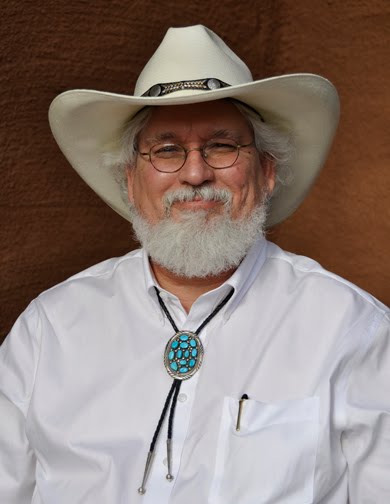 I am cognizant of the historical importance of Edward Sheriff Curtis' voluminous body of work and the contributions of other pioneering frontier photographers like Adam Clark Vorman, John Grabill, and Camillus "Buck” Sidney Fly. Nonetheless, I think of Ben Wittick (1845-1903) as the finest of all the early photographers whose work documented Western Native Americans widely perceived as inexorably disappearing from the landscape under the relentless expansion of a new dominant American culture. Ben Wittick had a photography studio in Gallup, New Mexico in the late 1880's which he later moved as his last studio operation 15 miles East to Ft. Wingate. Much of his work was done in the studio where he used props liberally. These included, painted backgrounds, regional plants, guns, pottery, and jewelry especially concho belts and naja necklaces. The image here is of the Navajo Woman, Old Washie (Credit Ben Wittick Collection Laboratory of Anthropology, Inc. Santa Fe, New Mexico). Ben Wittick had a special affinity for the Hopi Indians. He was the first known photographer to take images of the Hopi snake dances. He died in 1903 from a rattlesnake bite while collecting rattlesnakes for his Hopi friends. Many Americans do not know the Ben Wittick name, but most will recognize one of his most famous images taken in 1887, Geronimo!
I am cognizant of the historical importance of Edward Sheriff Curtis' voluminous body of work and the contributions of other pioneering frontier photographers like Adam Clark Vorman, John Grabill, and Camillus "Buck” Sidney Fly. Nonetheless, I think of Ben Wittick (1845-1903) as the finest of all the early photographers whose work documented Western Native Americans widely perceived as inexorably disappearing from the landscape under the relentless expansion of a new dominant American culture. Ben Wittick had a photography studio in Gallup, New Mexico in the late 1880's which he later moved as his last studio operation 15 miles East to Ft. Wingate. Much of his work was done in the studio where he used props liberally. These included, painted backgrounds, regional plants, guns, pottery, and jewelry especially concho belts and naja necklaces. The image here is of the Navajo Woman, Old Washie (Credit Ben Wittick Collection Laboratory of Anthropology, Inc. Santa Fe, New Mexico). Ben Wittick had a special affinity for the Hopi Indians. He was the first known photographer to take images of the Hopi snake dances. He died in 1903 from a rattlesnake bite while collecting rattlesnakes for his Hopi friends. Many Americans do not know the Ben Wittick name, but most will recognize one of his most famous images taken in 1887, Geronimo!Monday, May 24, 2010
Ben Wittick's Studio Jewelry & Pottery
 I am cognizant of the historical importance of Edward Sheriff Curtis' voluminous body of work and the contributions of other pioneering frontier photographers like Adam Clark Vorman, John Grabill, and Camillus "Buck” Sidney Fly. Nonetheless, I think of Ben Wittick (1845-1903) as the finest of all the early photographers whose work documented Western Native Americans widely perceived as inexorably disappearing from the landscape under the relentless expansion of a new dominant American culture. Ben Wittick had a photography studio in Gallup, New Mexico in the late 1880's which he later moved as his last studio operation 15 miles East to Ft. Wingate. Much of his work was done in the studio where he used props liberally. These included, painted backgrounds, regional plants, guns, pottery, and jewelry especially concho belts and naja necklaces. The image here is of the Navajo Woman, Old Washie (Credit Ben Wittick Collection Laboratory of Anthropology, Inc. Santa Fe, New Mexico). Ben Wittick had a special affinity for the Hopi Indians. He was the first known photographer to take images of the Hopi snake dances. He died in 1903 from a rattlesnake bite while collecting rattlesnakes for his Hopi friends. Many Americans do not know the Ben Wittick name, but most will recognize one of his most famous images taken in 1887, Geronimo!
I am cognizant of the historical importance of Edward Sheriff Curtis' voluminous body of work and the contributions of other pioneering frontier photographers like Adam Clark Vorman, John Grabill, and Camillus "Buck” Sidney Fly. Nonetheless, I think of Ben Wittick (1845-1903) as the finest of all the early photographers whose work documented Western Native Americans widely perceived as inexorably disappearing from the landscape under the relentless expansion of a new dominant American culture. Ben Wittick had a photography studio in Gallup, New Mexico in the late 1880's which he later moved as his last studio operation 15 miles East to Ft. Wingate. Much of his work was done in the studio where he used props liberally. These included, painted backgrounds, regional plants, guns, pottery, and jewelry especially concho belts and naja necklaces. The image here is of the Navajo Woman, Old Washie (Credit Ben Wittick Collection Laboratory of Anthropology, Inc. Santa Fe, New Mexico). Ben Wittick had a special affinity for the Hopi Indians. He was the first known photographer to take images of the Hopi snake dances. He died in 1903 from a rattlesnake bite while collecting rattlesnakes for his Hopi friends. Many Americans do not know the Ben Wittick name, but most will recognize one of his most famous images taken in 1887, Geronimo!

